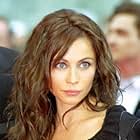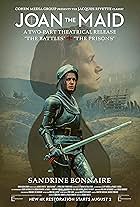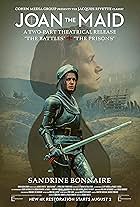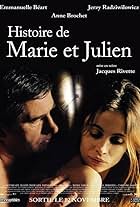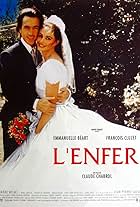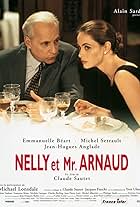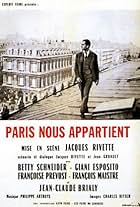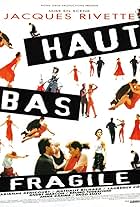IMDb RATING
7.5/10
9.7K
YOUR RATING
The former famous painter Frenhofer revisits an abandoned project using the girlfriend of a young visiting artist. Questions about truth, life, and artistic limits are explored.The former famous painter Frenhofer revisits an abandoned project using the girlfriend of a young visiting artist. Questions about truth, life, and artistic limits are explored.The former famous painter Frenhofer revisits an abandoned project using the girlfriend of a young visiting artist. Questions about truth, life, and artistic limits are explored.
- Awards
- 5 wins & 6 nominations
Daphne Goodfellow
- Deux touristes
- (as Daphné Goodfellow)
Storyline
Did you know
- TriviaThere was no script per se. The film was shot in sequential order and the day's shooting was dictated by what had been filmed the day before.
- GoofsAt the 2:13 mark (blu-ray edition) - as the camera begins to slowly close on Marianne settling on the couch, a mic sneaks into bottom of frame.
- Crazy creditsTous les dessins et peintures d'Edouard Frenhofer sont l'oeuvre de Bernard Dufour. All the drawings and paintings of Edouard Frenhofer are the work of Bernard Dufour.
- Alternate versionsShort version (125 minutes, less nudity, brighter lighting, almost different takes and editing) titled "Divertimento" showing for TV, then released theatrically in 1993.
- SoundtracksAgon
Music by Igor Stravinsky
Performed by Sinfonie-Orchester des Südwestfunks (as Orchestre de Südwestfunk de Baden-Baden)
Conducted by Hans Rosbaud
(avec l'autorisation des disques Adès)
Featured review
Unless you're a New Wavelet devotee or your intellectual capacities are wide, Jacques Rivette is a filmmaker who isn't very close to many average viewers. In many of his films he loses himself amid his intellectual ideas and doesn't mind developing them while neglecting notions of storytelling, progression in narration and time. Consequently, the average length of his works is of about two hours and a half. Many filmmakers left very long films too. But they keep in mind that their films are destined to be understood by the general public and so obey to rules of clarification in their accessible stories.
"La Belle Noiseuse" is one of his most palatable pieces of work in spite of its challenging length. It clocks in at 4 hours but don't panic, time won't seem long to you for Rivette keeps a decent linearity from the first reunion with the main characters of the film to the surprising final denouement to the agreement of Marianne (Emmanuelle Béart) to serve as a model for the painter Frenhofer (Michel Piccoli). Along their adventure, some details will witness the progression of the story: Marianne sleeps in Frenhofer's mansion while the latter falls asleep in his studio. An aesthetic refinement freely sourced from Honoré De Balzac's novel "the Unknown Masterpiece" and perhaps the son of "le Mystère Picasso" (1956) by Henri-Georges Clouzot, Rivette's piece of work is a dive in the twists and turns of artistic creation and all that it can comprise with its times of hopes, doubts, fears. Frenhofer naturally starts with a series of sketches and continues with numerous paintings attempts and countless, testing poses for Marianne. The two characters are engaged in a creative process that is highly likely to leave them exhausted to say the least. The filmmaker deftly taps the scenery of the mansion and notably the studio where he locks for the major part of the film, Marianne and Frenhofer for better and for worse. A painstaking care is given to sound with the squeaking of charcoal and brush. To better capture the sense of spontaneous creation, Rivette fell back on methods worthy of the New Wavelet and notably Godard's: he shot his film without a script near him and perhaps that's why many moments seem extemporaneous. But unlike Godard's smug works, Rivette's one remains quite understandable as a whole.
A dark legend surrounds this film about its success, one of the few Rivette enjoyed all along his career. Was it due to Emmanuelle Béart's nudity? "La Religieuse" (1966) was banned because it was deemed as shocking for a major part of the population according to the censors. This banning contributed to the popularity of the film. So, it would seem that Rivette has to put elements likely to be scabrous to make himself accepted by general public.
"La Belle Noiseuse" is one of his most palatable pieces of work in spite of its challenging length. It clocks in at 4 hours but don't panic, time won't seem long to you for Rivette keeps a decent linearity from the first reunion with the main characters of the film to the surprising final denouement to the agreement of Marianne (Emmanuelle Béart) to serve as a model for the painter Frenhofer (Michel Piccoli). Along their adventure, some details will witness the progression of the story: Marianne sleeps in Frenhofer's mansion while the latter falls asleep in his studio. An aesthetic refinement freely sourced from Honoré De Balzac's novel "the Unknown Masterpiece" and perhaps the son of "le Mystère Picasso" (1956) by Henri-Georges Clouzot, Rivette's piece of work is a dive in the twists and turns of artistic creation and all that it can comprise with its times of hopes, doubts, fears. Frenhofer naturally starts with a series of sketches and continues with numerous paintings attempts and countless, testing poses for Marianne. The two characters are engaged in a creative process that is highly likely to leave them exhausted to say the least. The filmmaker deftly taps the scenery of the mansion and notably the studio where he locks for the major part of the film, Marianne and Frenhofer for better and for worse. A painstaking care is given to sound with the squeaking of charcoal and brush. To better capture the sense of spontaneous creation, Rivette fell back on methods worthy of the New Wavelet and notably Godard's: he shot his film without a script near him and perhaps that's why many moments seem extemporaneous. But unlike Godard's smug works, Rivette's one remains quite understandable as a whole.
A dark legend surrounds this film about its success, one of the few Rivette enjoyed all along his career. Was it due to Emmanuelle Béart's nudity? "La Religieuse" (1966) was banned because it was deemed as shocking for a major part of the population according to the censors. This banning contributed to the popularity of the film. So, it would seem that Rivette has to put elements likely to be scabrous to make himself accepted by general public.
- dbdumonteil
- Feb 24, 2007
- Permalink
- How long is La Belle Noiseuse?Powered by Alexa
Details
- Release date
- Countries of origin
- Official site
- Languages
- Also known as
- The Beautiful Troublemaker
- Filming locations
- Assas, Hérault, France(Frenhofer's mansion and studio)
- Production companies
- See more company credits at IMDbPro
Box office
- Gross US & Canada
- $403,056
- Opening weekend US & Canada
- $1,887
- Nov 26, 2017
- Gross worldwide
- $403,056
- Runtime3 hours 58 minutes
- Color
- Aspect ratio
- 1.85 : 1
- 1.37 : 1
Contribute to this page
Suggest an edit or add missing content













